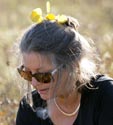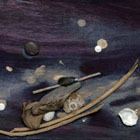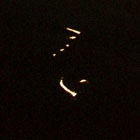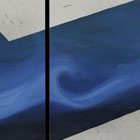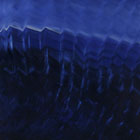NANCY L. PURINGTON
artwork | audio | 2008 update | galleries
artwork
audio 
(see also Art & Spirituality and Beyond 9-11: The Art of Renewal in Iowa)
- First memory (50 sec. | 345KB): listen | read
- Grandmother (51 sec. | 350KB): listen | read
- Husband (45 sec. | 309KB): listen | read
- Motherhood (28 sec. | 190KB): listen | read
- Artwork (60 sec. | 411KB): listen | read
- Advice (42 sec. | 291KB): listen | read
2008 update
What kind of artwork are you doing now, and how has your work changed in the last 10 years?
Since the 1960s, my themes have included visions of beauty and natural phenomena from places where I grew up and visited often: Mississippi River, Lake Superior, Rocky Mountains, clouds in the sky, planets, stars, galaxies and flowers in my garden. I like to study design and form in nature and extract the essence of line and structure to use in my compositions.
I continue to paint with gouache on paper, and oil on canvas or wood panel as I have since the 1960s. In the 1970s, I began to cut painted/printed papers into shapes and compose into 'poem papers', a style of collage. In 2002, I bought a digital camera and now incorporate images of subjects studied since childhood, i.e., mountains, clouds and waves. In 2003, I began to adhere 'sticks, stones, shells, pearls' to the painted wood panels to create assemblages. Since 2004, I have made an effort to confine my focus to works inspired by the Mississippi River in Iowa and water-related subjects including clouds.
2007 Iowa Arts Council Major Artist Grant
TWELVE VIEWS OF WATER
I will create and frame photographs and artworks exploring new and expanded approaches/directions/materials in compositions inspired by Mississippi River. Statewide exhibition tour will be developed and sponsored by the Muscatine Art Center. Project includes production of full-color, companion exhibition catalogue funded by Waterloo Center for the Arts.
Funded in part with a grant from the Iowa Arts Council, a division of the Iowa Department of Cultural Affairs, and the National Endowment for the Arts.
What motivates you to continue making art?
Studying transformation through observing wave patterns on the surface of the Mississippi River while simultaneously experiencing the attraction from the force of an invisible current identifies the place of origin for my investigations into the realm of infinite change.
Where does Change begin?
What shape does it take?
What form does it make?
These are the questions that formed inside my elementary school age mind while growing up along the banks of the Father Of All Waters. In my search for clues I created compositions painted from a lexicon of images collected over a lifetime of observations, experiences and memories from my life on the Mississippi River in Iowa. The artworks became illustrations and metaphors about the mysterious adventures of human existence.
Recently I have been listening to original compositions by Bix Beiderbecke. We were both born in Davenport, Iowa, where the river runs east and west. This particular zig-zag of the current creates patterns and compositions unique within the river's continental course. When I hear Bix's work I see and feel an undercurrent of blues decorated with jazzy wave patterns, juxtaposing rhythms and sequences phrased in a familiar framework of time. Were we both responding to an atmospheric opera presented by the Mississippi River in Scott County?
This year I have given titles to some new artworks that echo titles from Bix's music: In The Dark, In A Mist, Futuristic Rhythm, Davenport Blues, Clouds.
audio text
First memory
My earliest memory—I think I was around two years old, and my mother took me to VanderVeer Park in Davenport. They have a botanical interior garden greenhouse. They must have had a statue of a man. My memory is that that statue became animated; it either came forward or spoke to me or looked at me—something happened there. Seeing this little statue is very consistent with the kind of joy of life that I was fed. I was incredibly happy. I had above normal eyesight. So my vision brought me so much detail far and near that I think that's almost one of the reasons I became a visual artist. I'm not a conceptual artist; I'm not a political artist. I'm inspired from what I see.
Grandmother
My grandmother encouraged me. When I would stay with her in Chicago she would make doodles on a piece of paper, and then she'd give them to me and she'd say, "Here, make this into something." And, I mean, it was wonderful that she had that kind of time to encourage me. And then of course, she loved everything I did, so that's all an artist needs. But also her taking me to the galleries early. I think when I was ten there was some kind of an installation at the Chicago Art Institute of Wassily Kandinsky's work. It was mainly his COMPOSITIONS that are numbered, and they're quite abstract. I just was so taken with those pieces—it spoke to me is all I can say, and I knew that I would be working in the visual arts.
Husband
He has been very, very supportive. I know a lot of women artists have husbands who don't get it. I mean, you'd want to say they aren't supportive, but I think more than that, they don't get it. And that can be deadly because where it hits you is in the spirit, and where all this begins is in the spirit. You need to be totally left alone in all of your thoughts. The only other thing you need is encouragement. And even to consider someone else's observation can throw you off. And if that observation is tinged with an attitude of anything other than encouragement, you can be thrown off. So I'm very lucky to have someone who knows.
Motherhood
I wanted to be a mother and a teacher and an artist—actually I wanted to be an artist and a teacher and a mother, it would be in that order. And pretty much, my art has dominated everything. I wouldn't say I was the best mother—well, I would say I was the best mother I could be, but certainly I don't think my children came first. But on the other hand, I don't think that they suffered too much. They're both independent and they have to become that way.
Artwork
Overall my work describes a yearning for peace or a yearning for serenity or a yearning for balance and harmony. They are very well ordered. And I try to make all the transitions be smooth and upbeat. And I still focus on things in nature that give me a specific kind of feeling of wonder and beauty and probably hope or something positive. Or mystery, definitely has to have some kind of mystery in it. The work is all two-dimensional, and flat forms. I have two lines of work, one which is the river, and the other which is botanicals—flowers and leaves that are done from nature. I hope that when people look at the work they get that same kind of sense balance and wonder, mystery.
Advice
You must go to an art institute for your undergraduate work. Do not try to go to a university or a large school or even a liberal arts college, because developing self-discipline is probably the only thing that's going to see you through. If you don't develop those habits right on early, I think that's where a lot of artists miss a beat—developing discipline early.
One of the things my mother taught me was, Do not hang around negative people. If you are around someone who poisons the air with their negative thinking, it will affect your life. So you should let those people move on, and position yourself away only in a positive climate.

